Are you eager to master the art of haircutting? “How To Learn To Cut Hair” is a question many aspiring stylists and DIY enthusiasts ask. At LEARNS.EDU.VN, we believe everyone can learn this valuable skill with the right guidance and practice. This guide provides expert techniques, step-by-step instructions, and essential tips to help you confidently create stylish haircuts. Discover proven methods for enhancing your haircutting abilities and access in-depth tutorials for continuous improvement.
1. Understanding the Fundamentals of Hair Cutting
Before diving into complex styles, it’s crucial to grasp the basics. These foundational elements form the bedrock of every successful haircut and provide a solid base for future learning.
1.1. Essential Tools and Equipment
Having the right tools is paramount. High-quality equipment can make the process smoother and the results more professional. Here’s a list of essential tools:
| Tool | Description | Benefits |
|---|---|---|
| Haircutting Shears | Sharp, professional-grade scissors designed specifically for cutting hair. | Ensure clean, precise cuts, reducing the risk of split ends and uneven lines. |
| Thinning Shears | Scissors with notched blades used to remove bulk and blend layers. | Help create texture, soften harsh lines, and reduce weight in thick hair. |
| Hair Clippers | Electric tool used for creating short haircuts, fades, and undercuts. | Allow for efficient and even trimming, especially useful for men’s haircuts and detailed work. |
| Combs | Various types of combs (wide-tooth, fine-tooth, tail comb) for sectioning. | Facilitate precise sectioning, detangling, and styling, ensuring even distribution of hair during cutting. |
| Spray Bottle | Used to dampen hair for easier cutting. | Helps maintain consistent moisture levels, making hair more manageable and easier to cut accurately. |
| Hair Clips | Used to hold sections of hair out of the way. | Keep sections separated, preventing interference and ensuring clear visibility of the area being cut. |
| Cutting Cape | Protects clothing from hair clippings. | Provides a clean and professional experience for both the stylist and the client, preventing stray hairs from getting onto clothing. |
| Neck Duster | Brush used to remove hair from the neck and face. | Ensures comfort and cleanliness for the client by removing loose hairs after the haircut. |
| Mannequin Head | Training head used for practicing haircutting techniques. | Allows for experimentation and practice without the pressure of working on a live person, helping to build confidence and refine skills. |
| Hair Dryer & Diffuser | Used for styling and texturizing hair after cutting. | Helps set the final style, add volume, and define curls or waves, enhancing the overall look of the haircut. |
| Mirror | Provides a clear view of the haircut from all angles. | Allows for self-assessment and ensures symmetry and balance in the haircut, helping to identify and correct any imperfections. |
| Barbicide | A disinfectant used to sanitize your equipment | Maintaining high level of hygiene is very important. Barbicide ensures that there is no bacteria left on the equipment |
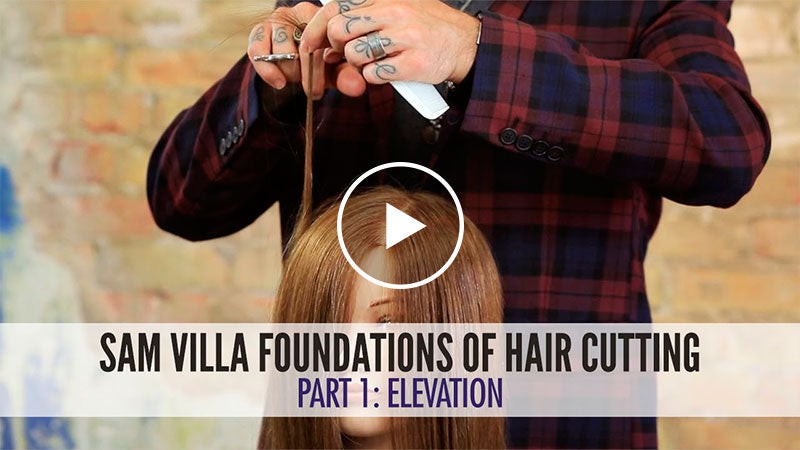
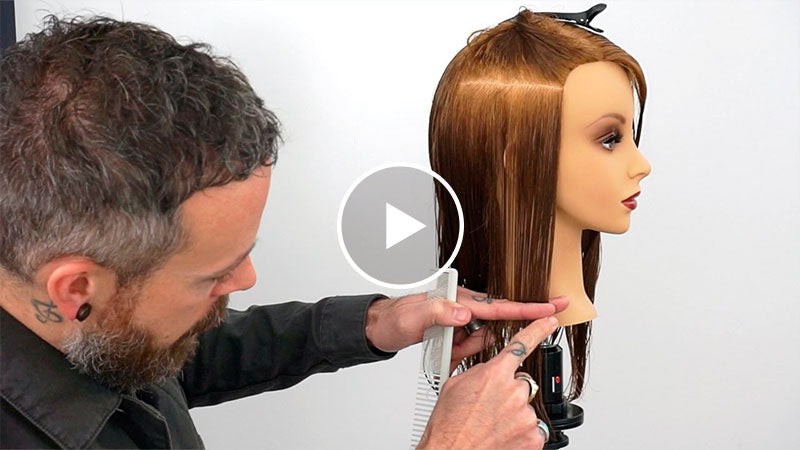
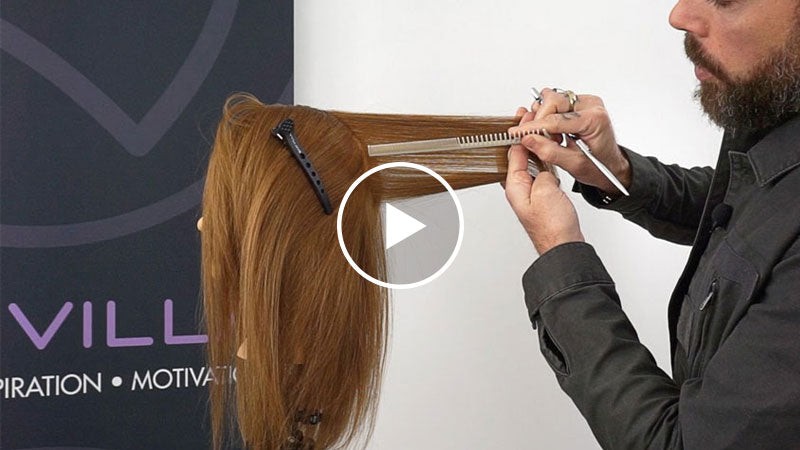
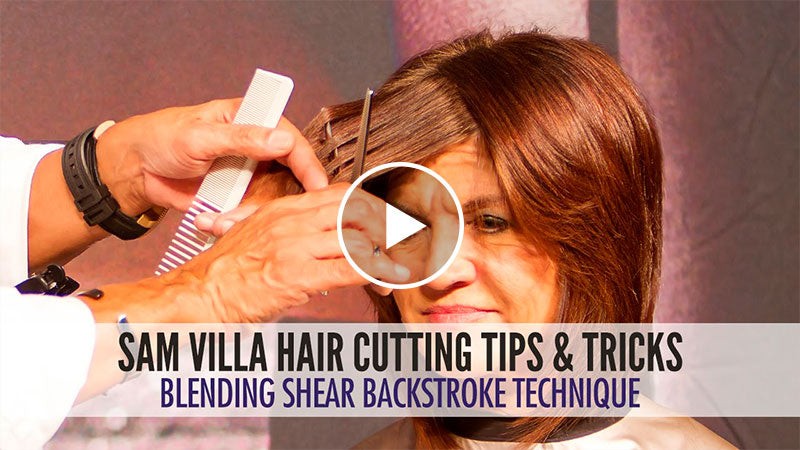
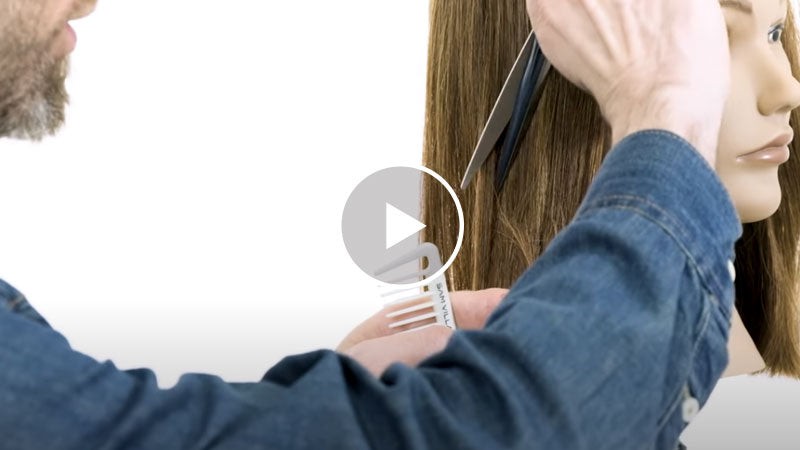

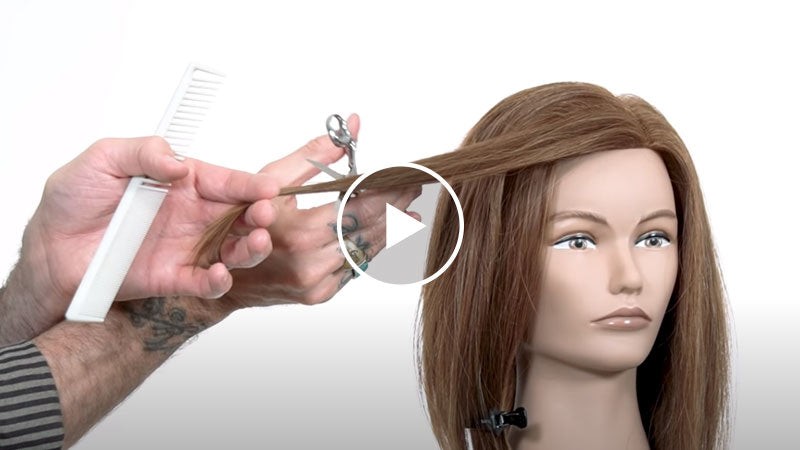
1.2. Basic Hair Cutting Techniques
These techniques are essential for any beginner:
- Point Cutting: Softening the ends by cutting into the hair at an angle.
- Blunt Cut: Creating a straight, even line.
- Layering: Cutting hair at different lengths to add volume and movement.
- Graduation: Creating a gradual increase in length, typically used in bobs.
- Slicing: Removing bulk by gliding the shears along the hair shaft.
1.3. Sectioning and Elevation
- Sectioning: Dividing the hair into manageable parts for precise cutting. Common sections include the top, sides, and back.
- Elevation: Lifting the hair away from the head before cutting. The angle of elevation determines the amount of layering.
- 0 degrees: No elevation, results in a blunt cut.
- 45 degrees: Creates a slight graduation.
- 90 degrees: Produces even layering.
- Over 90 degrees: Creates more extreme layering.
1.4. Understanding Hair Types and Textures
Different hair types require different approaches. Here’s a basic overview:
| Hair Type | Characteristics | Cutting Considerations |
|---|---|---|
| Fine Hair | Thin strands, lacks volume. | Avoid over-layering, which can make hair look even thinner. Use point cutting to soften edges without removing too much bulk. |
| Medium Hair | Average thickness, versatile. | Can handle most cutting techniques. Layering can add volume and movement without sacrificing density. |
| Thick Hair | Dense strands, can be heavy and difficult to manage. | Thinning shears can remove bulk. Use layering to create shape and prevent a boxy appearance. |
| Straight Hair | Lies flat, reflects light well. | Blunt cuts and long layers work well. Avoid heavy layering that can create a stringy look. |
| Wavy Hair | S-shaped pattern, prone to frizz. | Layering can enhance natural waves. Cut in dry to avoid surprises with shrinkage. |
| Curly Hair | Defined curls, can be dry and fragile. | Cut in dry to see the natural curl pattern. Use minimal tension and avoid thinning shears, which can create frizz. |
| Coily Hair | Tight, Z-shaped pattern, very dry. | Moisturize thoroughly before cutting. Use a “dusting” technique to trim ends without disrupting the curl pattern. |
2. Step-by-Step Hair Cutting Guides
Let’s explore some practical guides to help you master different haircuts.
2.1. How to Cut a Basic Bob
A bob is a timeless and versatile style. Here’s how to achieve it:
- Prepare: Dampen the hair and comb through to remove any tangles.
- Section: Divide the hair into four sections: top, left side, right side, and back.
- Cut the Back: Start at the nape of the neck and cut a blunt line to your desired length. Use a comb to ensure the hair is evenly distributed.
- Cut the Sides: Bring the side sections forward and cut them to match the length of the back section.
- Check for Symmetry: Use a mirror to ensure both sides are even. Make any necessary adjustments.
- Refine: Point cut the ends to soften the line and remove any harshness.
Remember, creating a consistent line on both sides of any one-length haircut is always a challenge, but we’ve got some solutions. Use your comb to guide the bottom of your fingers to create a horizontal line. Your elbow can also drag the line down and throw off the ability to create a truly horizontal line. Instead, use your comb to help create the perfect line. Watch the video to see exactly how to create a consistent line each and every time.
2.2. How to Cut Layers
Layering adds volume and movement. Here’s a guide to creating basic layers:
- Prepare: Dampen the hair and comb through.
- Section: Divide the hair into top, left side, right side, and back sections.
- Establish the Guide: Take a small section at the crown of the head and elevate it to 90 degrees. Cut to your desired length for the shortest layer.
- Cut the Layers: Take subsequent sections, elevating them to 90 degrees and cutting them to match the length of the guide.
- Blend: Point cut the ends to blend the layers seamlessly.
- Check: Ensure the layers are even and balanced.
Remember that a common problem with layered haircuts is inconsistency within the weight balance. To improve this, examine the element of elevation to control the shape of the layer. Sections that are too large can create inconsistency. Sub-section large sections into two smaller pieces makes it easier to control elevation. Also, your elbow-down side will be your heavy side and your elbow-up side will be your lighter side.
2.3. How to Cut Bangs
Bangs can transform a look. Here’s how to cut them effectively:
- Prepare: Dry cut is recommended for bangs, comb them forward.
- Section: Create a triangular section at the front of the hairline.
- Cut: Use point cutting to avoid a blunt edge, ensure it is even, and not too thick.
- Refine: Point cut the ends to soften the line and add texture.
The technique to remove weight and add volume in the fringe area is the Blending Shear Backstroke Technique. Start by taking a diagonal forward slice. Over-direct the hair so it moves back and away from the face. Place the blunt blade of the Sam Villa Invisiblend Shear in the hair on the diagonal and weave it through. Close, backstroke, open, close, backstroke and release the section.
3. Advanced Hair Cutting Techniques
Once you’ve mastered the basics, challenge yourself with these advanced techniques.
3.1. Texturizing
Texturizing involves removing weight to create movement and definition. Techniques include:
| Technique | Description | Best For |
|---|---|---|
| Point Cutting | Softening ends by cutting into the hair at an angle. | Adding subtle texture to any hair type. |
| Slicing | Removing bulk by gliding the shears along the hair shaft. | Thick hair needing significant weight removal. |
| Notching | Creating small, random cuts to remove weight and create a choppy effect. | Short, edgy styles. |
| Channel Cutting | Taking out deeper sections of hair to create more dramatic texture. | Styles requiring pronounced texture and movement. |
| Slithering | Similar to slicing, but with a more pronounced angle and faster movement. | Creating soft, blended layers. |
| Pinching | Holding small sections and cutting into them to create diffused weight removal. | Fine hair needing subtle lift and volume. |
Highly textured, layered hairstyles are continually trending. The entry angle of your shear relative to the grain of the hair is key to creating beautiful textured blunt cuts. The tool and technique you choose should depend on your desired result as well as your guest’s hair type.
3.2. Razor Cutting
Using a razor can create soft, textured layers that are difficult to achieve with shears. Tips for razor cutting:
- Use a Sharp Razor: A dull razor will pull and damage the hair.
- Work on Damp Hair: This helps the razor glide smoothly.
- Use a Guard: Protect your fingers and prevent accidental cuts.
- Angle: Use a shallow angle to create soft layers.
- Moisturize: Razor cutting can be drying, so use a hydrating product afterward.
Creating face framing layers with a razor is a great technique to create a highly textured feel in one step. With this technique, the Sam Villa Signature Series Razor is essential. Since you’ll be working on dry hair, prep the hair with Redken Shine Flash shine mist to add a bit of slide.
3.3. Advanced Layering Techniques
These techniques create specific effects:
- Invisible Layers: These are internal layers to add volume and movement to the hair without creating visible layers. This technique is ideal that adds fullness, movement, and body to a haircut without creating visible layers. Start by sectioning off dry hair behind the ears at the place where the hair density changes. Then elevate the hair at a 90 degree angle and use your Sam Villa Artist Series 6″ Slide Cutting Shears to cut the hair from short to long, beginning at the natural bend point.
- Disconnected Layers: Removing bulk, keeping length and speeding up blow drying time with this technique. To create disconnected layers, create an under layer, not an undercut. Start by slicing out a zigzag section above the ear and isolating that section.
4. Cutting Hair at Home: A Beginner’s Guide
If you’re cutting your own hair or helping a family member, here are some tips:
- Start Simple: Begin with trims or basic cuts to build confidence.
- Use Sharp Shears: Dull scissors can damage hair.
- Take Your Time: Rushing can lead to mistakes.
- Use Mirrors: Ensure you can see all angles.
- Follow Tutorials: Watch videos and read guides for step-by-step instructions.
4.1. Safety First
- Always use sharp shears designed for cutting hair.
- Keep your tools clean and sanitized.
- Work in a well-lit area to avoid mistakes.
4.2. Cutting Your Own Hair
- Prepare: Dampen the hair and comb through.
- Section: Divide the hair into manageable sections.
- Trim the Ends: Use a mirror to guide you, cutting straight across or point cutting for a softer edge.
- Check for Symmetry: Ensure both sides are even.
- Refine: Make any necessary adjustments.
4.3. Cutting a Child’s Hair
- Distract: Use a TV show or game to keep them still.
- Work Quickly: Children have short attention spans.
- Be Patient: Avoid rushing, but be prepared for movement.
- Use a Cape: Protect their clothing.
5. Common Hair Cutting Mistakes and How to Avoid Them
Even experienced stylists make mistakes. Here are some common pitfalls and how to steer clear of them:
| Mistake | Solution |
|---|---|
| Uneven Cuts | Double-check symmetry using mirrors and a comb to measure lengths. |
| Cutting Too Much | Cut conservatively, especially when layering. You can always cut more, but you can’t add hair back. |
| Blunt, Choppy Layers | Point cut the ends to soften the line and blend the layers. |
| Over-Thinning | Use thinning shears sparingly, especially on fine hair. |
| Cutting on Dry, Damaged Hair | Always dampen the hair for better control. Use a moisturizing product afterward. |
| Ignoring Hair Growth Patterns | Pay attention to natural partings and cowlicks. Adjust your cutting technique accordingly. |
| Not Consulting the Client | Discuss their desired look and hair care routine before starting. |
6. Maintaining and Enhancing Your Hair Cutting Skills
Practice makes perfect. Here are ways to continuously improve:
6.1. Online Resources and Tutorials
LEARNS.EDU.VN offers a wealth of resources, including:
- Video Tutorials: Step-by-step guides for various haircuts.
- Expert Articles: In-depth articles on techniques, tools, and trends.
- Community Forums: Connect with other learners and share tips and advice.
6.2. Advanced Learning Options
Consider these options to elevate your skills:
- Cosmetology School: A formal education provides comprehensive training.
- Workshops and Seminars: Attend industry events to learn from experts.
- Apprenticeships: Work under an experienced stylist to gain hands-on experience.
6.3. Staying Updated with Trends
The world of hairstyling is constantly evolving. Keep up with the latest trends by:
- Following Industry Blogs and Magazines: Stay informed about new styles and techniques.
- Using Social Media: Follow stylists and influencers on platforms like Instagram and Pinterest.
- Experimenting: Try new styles on mannequin heads or willing friends.
7. The Business of Hair Cutting
If you’re considering a career in hairstyling, here are some key aspects to consider:
7.1. Building a Clientele
- Networking: Connect with potential clients through social media, community events, and referrals.
- Offering Promotions: Attract new clients with discounts and special offers.
- Providing Excellent Service: Word-of-mouth is powerful. Ensure every client has a positive experience.
- Creating a Portfolio: Showcase your best work to attract new clients.
- Online Booking: Make it easy for clients to schedule appointments.
7.2. Setting Prices
Consider these factors when determining your prices:
- Experience Level: Charge more as your skills and experience grow.
- Location: Prices vary depending on your geographic area.
- Services Offered: Factor in the complexity and time required for each service.
- Overhead Costs: Consider the cost of supplies, rent, and utilities.
7.3. Marketing Your Services
Effective marketing can help you stand out. Consider these strategies:
- Website: Showcase your services, prices, and portfolio.
- Social Media: Engage with potential clients and share your work.
- Local Advertising: Place ads in local newspapers, magazines, or online directories.
- Collaborations: Partner with other businesses (e.g., salons, spas) for cross-promotion.
8. Hair Cutting for Specific Occasions
Different occasions call for different styles. Here are some tips for creating the perfect look:
8.1. Wedding Hair
- Consultation: Discuss the bride’s vision and the overall theme of the wedding.
- Trial Run: Practice the style in advance to ensure it meets expectations.
- Long-Lasting Styles: Use products that provide hold and prevent frizz.
- Consider Accessories: Incorporate veils, headbands, or flowers.
8.2. Prom Hair
- Trendy Styles: Keep up with the latest prom trends.
- Versatility: Create styles that complement different dress styles.
- Photo-Ready Looks: Use products that enhance shine and prevent flyaways.
8.3. Special Events
- Themed Styles: Tailor the hairstyle to the event’s theme.
- Unique Looks: Create styles that stand out and make a statement.
- Attention to Detail: Ensure every strand is perfectly in place.
9. Ethical Considerations in Hair Cutting
As a hair stylist, it’s important to consider ethical and professional standards.
9.1. Client Consultation and Consent
Always have a thorough consultation with your client to understand their preferences, lifestyle, and hair care routine. Ensure they fully understand the proposed style and agree to the treatment plan.
9.2. Inclusive Practices
Be mindful of cultural and personal preferences. Be knowledgeable about different hair types and textures, and offer inclusive services that cater to a diverse clientele.
9.3. Sustainability
Adopt sustainable practices in your salon or home setup. Use eco-friendly products, reduce waste, and conserve water.
10. Frequently Asked Questions (FAQ)
Here are some common questions about learning to cut hair:
- How long does it take to learn to cut hair professionally?
- It typically takes 1-2 years to complete cosmetology school and gain the necessary skills.
- Can I learn to cut hair at home?
- Yes, with practice and guidance from online resources, you can learn basic techniques at home.
- What are the essential tools for hair cutting?
- Haircutting shears, thinning shears, combs, hair clips, and a spray bottle are essential.
- How do I avoid making mistakes when cutting hair?
- Take your time, use sharp tools, and double-check symmetry.
- How do I maintain my hair cutting skills?
- Practice regularly, attend workshops, and stay updated with trends.
- Is it better to cut hair wet or dry?
- It depends on the technique and hair type. Wet cutting is common for blunt cuts, while dry cutting is preferred for textured styles.
- How do I choose the right haircut for my face shape?
- Consider styles that balance your features. Consult with a stylist for personalized recommendations.
- How do I create layers that don’t look choppy?
- Use point cutting to soften the ends and blend the layers.
- How do I remove weight from thick hair?
- Use thinning shears or slicing techniques.
- What are the latest trends in hair cutting?
- Stay updated by following industry blogs, magazines, and social media.
Learning how to cut hair is a rewarding journey that combines technical skills with creative expression. Whether you’re aiming for a professional career or simply want to trim your own locks, LEARNS.EDU.VN is here to support you every step of the way. Explore our comprehensive resources, practice diligently, and unleash your inner stylist. With dedication and the right guidance, you can master the art of haircutting and create stunning looks for yourself and others.
Ready to start your haircutting journey? Visit learns.edu.vn for more tutorials, expert tips, and comprehensive courses. Contact us at 123 Education Way, Learnville, CA 90210, United States or via WhatsApp at +1 555-555-1212. Start learning today and unlock your potential!